The 14 Most Beautiful Aquatic Flowers to Grow in Water
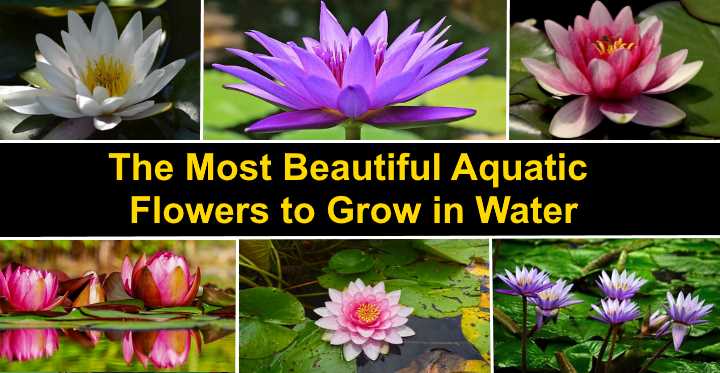
Stunning aquatic flowers add color and beauty to ponds, aquariums, water gardens, or jarrariums. Flowering plants floating on the water’s surface are spectacular to look at. More than just having aesthetic value, aquatic flowering plants help to oxygenate water in aquariums and fishponds. Also, the leaves of aquatic flowers provide food and shelter for fish.
Some of the best aquatic flowers are exotic lotus flowers, beautiful water lilies, and dainty water poppies. These plants have underwater roots that allow the leaves and flowers to float on the surface of the water. Also, elegant calla lilies can thrive in water gardens and ponds.
This article is a complete guide to the best flowering plants for growing in water. You’ll find out which flowers are ideal for ponds, and which ones are suitable for exotic freshwater fish tank.
What Are Aquatic Flowers?
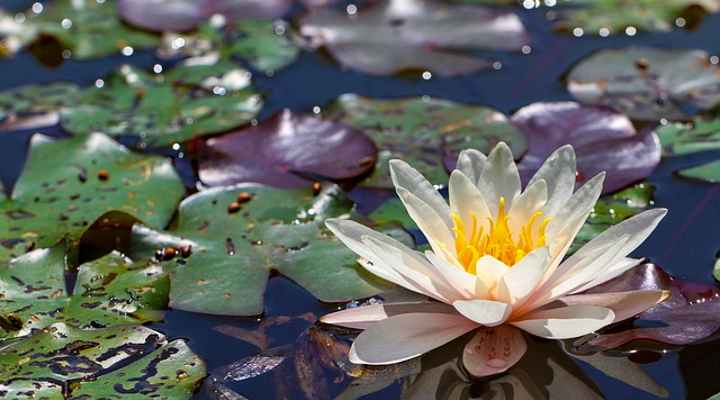
Many aquatic plants have beautiful floating flowers such as this water lily
Aquatic flowers are flowering plants that thrive in water environments. Plants that grow in water are called hydrophytes or aquatic macrophytes. Aquatic flowering plants can grow submerged in water, floating on water, or near bodies of water—for example, at the edges of lakes, streams, or ponds.
Some species of flowering aquatic plants grow entirely underwater. Other types of plants have root systems that thrive in soggy, damp soil, or soil that is always saturated with water.
For example, water lilies—the largest of the aquatic flowers—have roots that grow in submerged pond soil. Long stems grow under the water and reach the surface. There, large flat green leaves and showy flowers float elegantly on the surface.
Growing Indoor Aquatic Flowers in Water
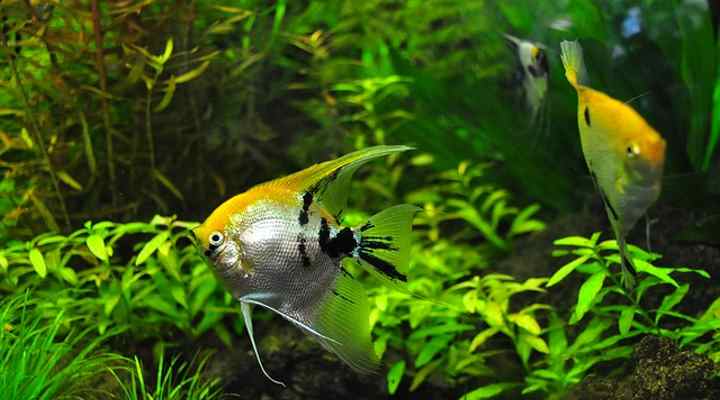
Flowering aquarium plants should be suitable to grow in low light conditions
Plants that flower in indoor ponds, water gardens, or aquariums should be adaptable to low light. Indoor aquatic flowers absorb nutrients from the water and root in the substrate at the tank’s bottom. Apart from ferns and mosses, most aquatic plants flower in water.
Some types of flowering plants such as anubias and sword plants will flower while submerged in water. Other blooming aquatic plants, such as lilies, will float on top of the water.
When growing flowering plants indoors, it’s vital to get light, fertilization, substrate, and water parameters right. Aquarium or indoor pond water should meet the proper requirements to promote fish health and encourage plants to flower.
Aquatic Flowers for Growing Indoors (With Pictures and Names)
Here are some of the best indoor aquatic flowers for your water garden, fish tank, or indoor pond.
Amazon Sword (Echinodorus)
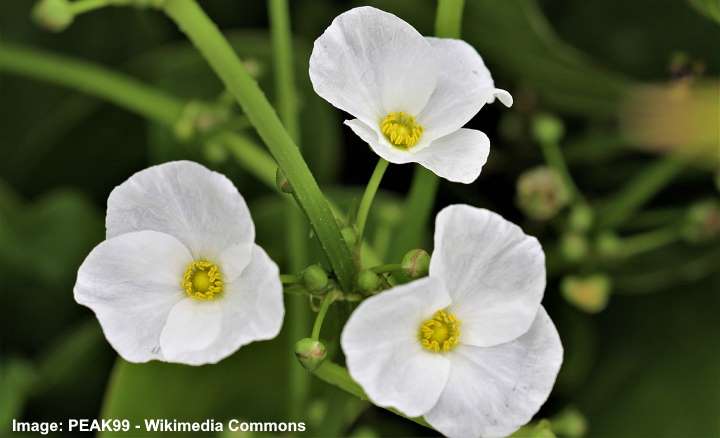
A close up picture of Echinodorus cordifolius white flowers
Amazon swords are one of the most popular indoor flowering plants that grow immersed in water. This species of attractive, easy-care aquatic plants has long triangular leaves and small flowers that grow on long submerged stems. Amazon sword plants are annual or perennial plants that grow well in low light in aquariums.
Amazon swords have bushy foliage that makes them ideal for decorative fish. The sword plants grow entirely submerged, and the larger plants have leaves that float on the surface. Amazon sword plants grow best in water that has tropical or sub-tropical temperatures.
Also called burhead, Amazon sword plants grow tall in aquariums. It’s best to grow sword plants at the back or center of your fish tank.
To encourage Amazon swords plants to flower in water, apply fertilizers to promote healthy growth. Although Amazon swords are hardy and easy-to-grow plants, some extra nutrients will help the flowers bloom regularly.
Anubias
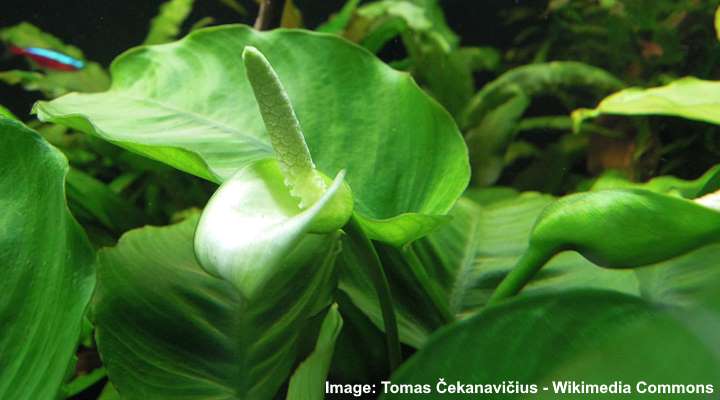
Anubias prefer low lighting and can also produce flowers submerged in water. In this image: Anubias barteri
Anubias is a genus of short aquatic plants that can produce – unlike most aquatic plants – flowers that wholly submerged in water. Anubias plants produce small creamy-white flowers that look like underwater peace lilies with a spathe and spadix. These low-maintenance, low-light water plants have thick dark leaves, and their leaf shape depends on the species.
Anubias aquatic plants are some of the easiest plants to keep in an aquarium. Their broad, long leaves provide shelter, protection, and oxygen for fish. Anubias are also ideal for fish tanks because herbivorous fish don’t eat the leaves. The aquatic plants are suitable for aquariums that have tetras, guppies, goldfish, or cichlids.
Anubias is a wetland plant that can also grow above water. If you have a paludarium at home, anubias are an ideal choice. Paludariums include a mix of terrestrial and aquatic plants.
Fanwort (Cabomba Aquatica)
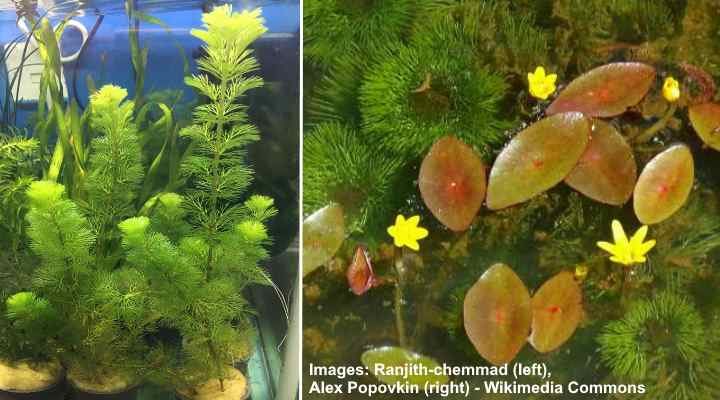
Cabomba Aquatica is a popular type of water plant with stems that usually reach the surface during flower production
Cabomba aquatica is a perennial flowering plant that thrives in water. As a popular aquarium plant, Cabomba aquatica produces dainty yellow flowers. This aquatic plant grows and flowers floating on the water or rooted in the aquarium substrate. The attractive feathery leaves are ideal for an aquarium backdrop.
Cabomba aquatica is a fast-growing plant, and its soft floating stems grow up to 20” (50 cm). The plant thrives submerged in water and doesn’t need much light.
Even though Cabomba aquatica is one of the best flowering floating plants for aquariums, it’s not ideal for all aquarium fish types. Goldfish and cichlids will eat their way through the delicate leaves.
Aquatic Flowers That Grow in Ponds Outdoors (With Pictures and Names)
Many flowers thrive in ponds, lakes, streams, or other bodies of water. If you have a garden pool, fishpond, or other water feature, flowers growing in water can enhance your garden’s aquatic landscape.
Here are some of the best outdoor aquatic flowers.
Fragrant Water Lily Flower (Nymphaea odorata)
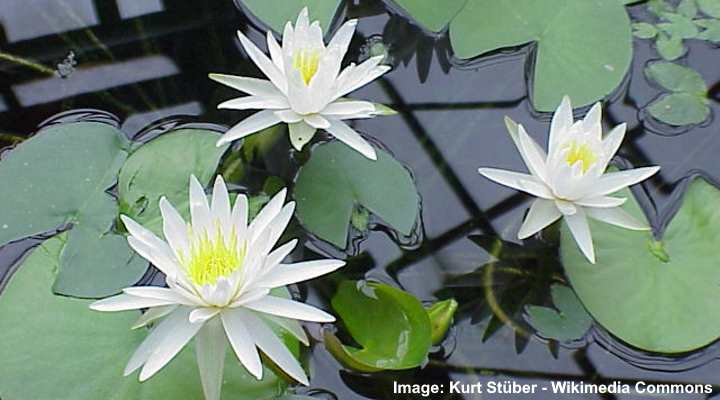
The beautiful flowers of water lily look great in ponds or water gardens
The white water lily is one of the best floating flowering aquatic plants for ponds or water gardens. Fragrant water lilies have large, showy white flowers, massive flat green leaves, and a sweet scent. The most attractive feature of water lilies is their large blossoms sitting on top of the water.
Also called the American water lily, these flowering perennial plants grow best in full sun. Grow in pond areas, water gardens, or bogs that are up to 2 ft. (0.6 m) deep.
Water lily roots grow in submerged soil. The floating leaves or lily pads can be up to 12” (30 cm) across. Water lily flowers either float on the water’s surface or grow above the water on erect stems.
Some smaller species of water lilies are ideal for aquariums. However, you’ll need to give the flowering plants plenty of light—around ten hours a day—to grow well in water and produce flowers.
American Lotus (Nelumbo lutea)

The ornamental flowers of the American lotus look at their best when grown in full sunlight
The American lotus flower is a striking perennial aquatic plant for ponds. American lotus plants have huge umbrella-like leaves up to 2 ft. (0.6 m) across. Large pale yellow flowers emerge from water on the end of stiff stems. Spectacular lotus flowers can grow up to 1 ft. (0.3 m) across.
Lotus flowers grow from tuberous roots that are submerged in pond beds. The aquatic flowers bloom in full sun during the summer. Grow in small garden ponds, water gardens, or outdoor fishponds. The long flower stems grow to between 3 and 6 ft. (1 – 1.8 m) tall.
Grow lotus flowers in containers in ponds to prevent them from becoming invasive. Lotus flowers are also ideal for planting at pond edges. If you grow lotus plants in a shallow pond less than 6” (15 cm) deep, move the container to deeper water to protect the plant during winter.
American lotus flowers are ideal for growing in USDA zones 4 through 11.
Water Hawthorn (Aponogeton distachyos)
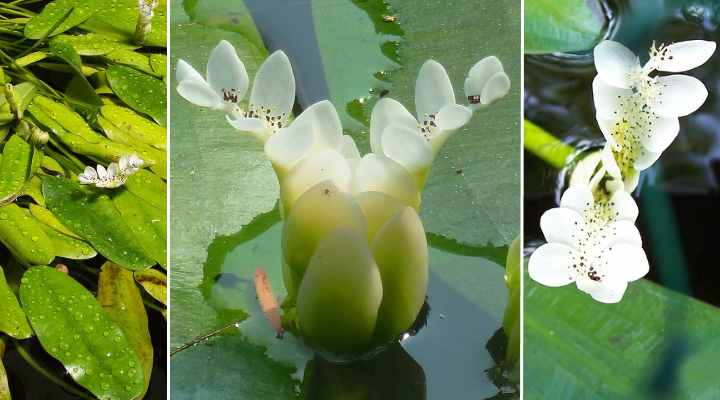
The flowers of water hawthorn are produced on a stem above the water surface
Water hawthorn or cape pondweed is an aquatic plant with flowers emerging from the water. Water hawthorn plants are an ideal choice for growing in ponds, fishponds, or water gardens. The floating leaves and the flowers above the water’s surface create a cover of green foliage and white flowers.
Water hawthorn plants have narrow oval leaves up to 10” (25 cm) long. Sweetly-scented flowers rise above the water on the end stiff stems. The delicate flowers are made up of small yellowish-white petals. Grow in garden ponds that are up to 18” (0.5 m) deep and in full sun or partial shade.
Species of Aponogeton are also popular flowering aquarium plants.
Water Hyacinth (Eichhornia crassipes)
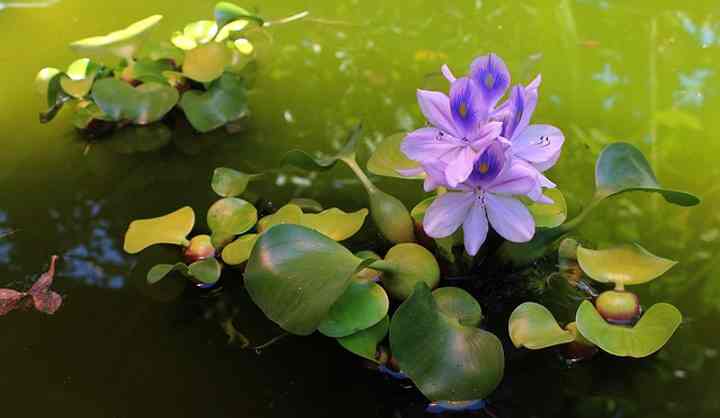
The decorative flowers of water hyacinth grace outdoor ponds but the plant can become invasive
Water hyacinth is an ornamental floating aquatic flower that has stunning pink, violet or pale blue blossoms. Water hyacinth flowers grow as colorful spikes emerging from thick glossy foliage. The leaves and flowers float on the water’s surface, where it quickly grows and spreads.
These aquatic plants can become invasive and take over ponds. If the pond cover becomes too dense, water hyacinths can block sunlight and starve the pond of algae and plankton. If you have fish in your pond, it’s best to grow aquatic hyacinths in floating baskets.
Water hyacinths thrive in full sun in USDA zones 9 to 11.
Pickerelweed (Pontederia cordata)
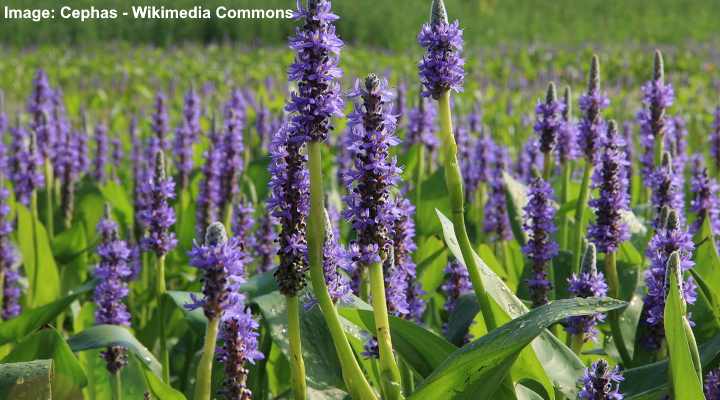
Pickerelweed is an attractive water garden plant with purple flowers that bloom in late summer
Pickerelweed is a flowering plant that grows in ponds, lakes, rivers, and wetlands. As an aquatic plant, pickerelweed is an emergent plant—its roots grow in submerged soil, and foliage and flowers grow above the water. Pickerelweed produces spikes of purple flower clusters and has large green leaves.
Pickerelweed has vigorous growth and thrives in marshy, wet conditions, and full sun. You can grow the aquatic plant beside or in garden ponds. To prevent the plant from spreading too much, grow in containers submerged in water.
Pickerelweed is also an excellent choice to grow flowering plants in a fishpond. Freshwater fish, including pickerel or pike, shelter in the plant’s dense foliage.
Pickerelweed grows in aquatic and muddy conditions in USDA zones 3 to 10.
Broadleaf Arrowhead (Sagittaria latifolia)
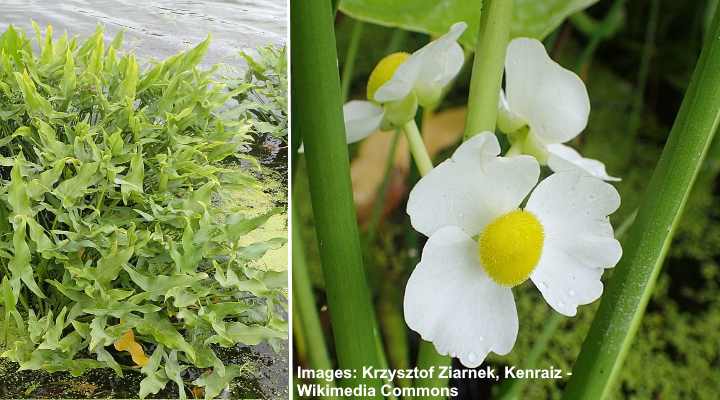
Broadleaf Arrowhead water plant can be found along ponds, rivers and lakes and has white flowers with yellow centers
Broadleaf arrowhead is a marginal aquatic perennial flowering plant for water gardens and ponds. As its common name suggests, broadleaf arrowhead plants have large arrow-shaped leaves. Leaves can grow submerged or emerged, and white flowers rise above the water’s surface.
Broadleaf arrowhead grows in ponds up to 12” (30 cm) deep. The clumping plant grows between 1 and 4 ft. (0.3 – 1.2 m) tall. Dainty flowers grow at the end of 4-ft. (1.2 m) long stems. The arrowhead leaves can grow up to 12” (30 cm) long.
Grow broadleaf arrowhead flowering plants in zones 5 – 11. The vigorous, easy-to-grow aquatic plants need full sun and wet loamy soil to thrive.
Water Poppy (Hydrocleys nymphoides)
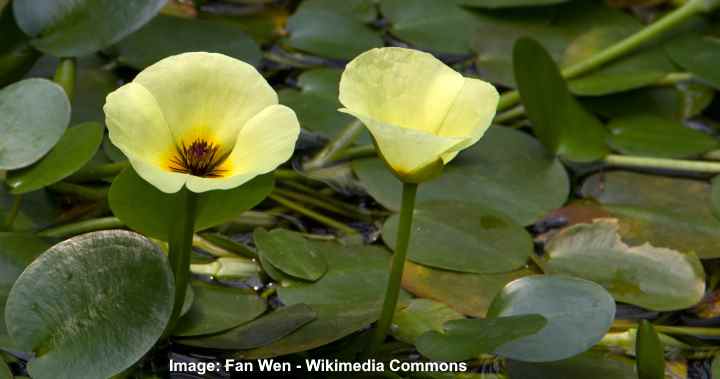
Water poppy has delicate pale yellow flowers and is grown in ponds or aquatic habitats
Water poppies are marginal perennial pond plants with leaves that float on water and 3-petaled flowers that grow on top of erect stems. Water poppy plants have small yellow flowers that bloom throughout the summer. The rounded leaves of water poppies are about 3” or 4” across, and they spread across the surface of ponds.
Water poppy flowers grow in warmer climates and bloom when the temperature is at least 70°F (21°C). Water poppies thrive in water that’s 6” (15 cm) deep. You can also grow water poppies at the edges of ponds or water gardens.
Water poppies grow best in USDA zones 9 – 11.
Water Iris (Iris laevigata)

Water iris grows in shallow water and is also called Japanese iris
Water irises are aquatic perennials with purple-blue papery flowers on the ends of long stems. The showy flowers have three striking petals that are 4” (10 cm) wide and grow at the ends of 3-ft. (1 m) tall stems. Lime-green sword-shaped leaves provide a stunning contrast with the deep purple blossoms.
Easy to grow in water, the Iris laevigata is an ideal choice for planting at pond margins, near streams, or in mixed aquatic borders. The clumping plant thrives in wet, rich soil in full sun or partial shade. As an emergent aquatic plant, you can also plant the irises with their roots fully submerged in water.
Calla Lilies (Zantedeschia aethiopica)

You can plant calla lilies in shallow water at the edge of a pond
Calla lilies are not generally thought of as a pond plant, but they grow well in aquatic environments. Calla lilies have sizeable white trumpet-shaped flowers with a striking yellow spadix. Clumps of large glossy green leaves contrast with the brilliant white flowers. Calla lilies will bloom in water from spring until late summer.
You can grow calla lilies as a marginal pond plant. The moisture-loving flowers can grow in up to 12” (30 cm) of water at the edge of water gardens or ponds. The striking flowers grow to between 2 and 3 ft. (0.6 – 1 m) above the surface of the water.
Calla lilies are perennial cold-hardy plants in zones 7 – 11. If you live in colder climates, you can grow calla lilies in containers and overwinter them indoors. Not only are calla lilies beautiful aquatic flowers, but they are also ideal container plants for patios, decks, or in mixed borders.
Water Forget-Me-Not (Myosotis scorpioides)

Water Forget-Me-Not thrives in wet habitats and has delicate pale blue small flowers
Water forget-me-not is a flowering aquatic plant that is ideal for wet garden areas, water gardens, or as a marginal pond plant. These forget-me-not plants have sprays of tiny light blue flowers that blossom in summer. The aquatic plants have semi-evergreen foliage. Water forget-me-not plants thrive in poorly-drained soil.
Perennial forget-me-not plants have a spreading nature. The easy-care plant thrives around bogs, ponds, water gardens, or stream banks. The forget-me-nots can grow submerged in water just as well as in moist, soggy soil. The water-loving flowering plant can form floating rafts.
Also called scorpion grass, this flowering aquatic plant thrives in full sun or partial shade.
Apart from growing near bodies of water, Myosotis scorpioides is an excellent ground cover plant for full sun. This is one of the best ground cover plant choices to cover bare ground that has poor drainage.
Water forget-me-nots are ideal for growing in zones 5 – 9.
Mosaic Flower (Lugwigia sedoides)
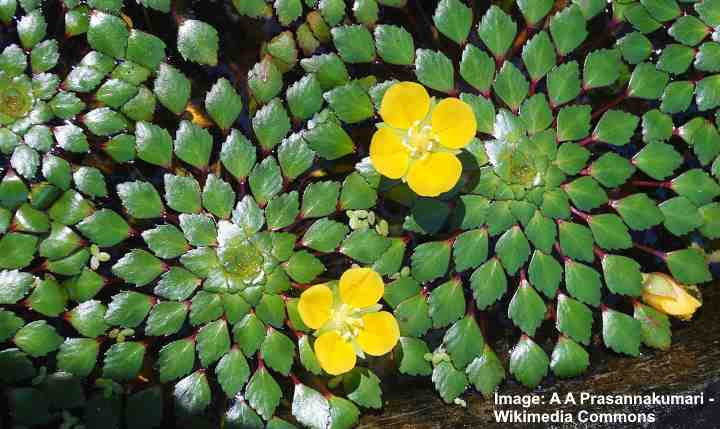
The mosaic flower is a floating pond plant that blooms from June to August
Mosaic flowers or false loosestrife are floating perennial plants for ponds, lakes, and swampy ground. Mosaic flowers have diamond-shaped thick leaves that grow in rounded clusters—just like a mosaic pattern. Small yellow flowers float in among the leaves creating a fascinating pond cover.
Mosaic flowers are floating aquatic plants for tropical climates. Thriving in zones 10 and 11, you can grow these annuals in containers and submerge in ponds up to 1.5 ft. (0.5 m) deep. The delightful yellow flowers appear on the water between June and August. Grow mosaic flowers in full sun for best results.
Related articles:
